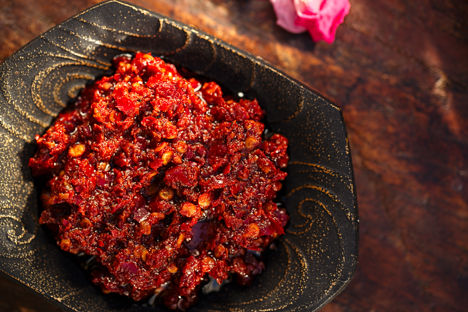
Ingredient focus: harissa
Harissa has become a bit of a store cupboard staple over the last few years, but what is it that makes this fiery, flavourful paste so special? Pete Dreyer takes a deep dive into this much-loved ingredient and looks at a few fantastic recipes that put it centre stage.
Ingredient focus: harissa
Harissa has become a bit of a store cupboard staple over the last few years, but what is it that makes this fiery, flavourful paste so special? Pete Dreyer takes a deep dive into this much-loved ingredient and looks at a few fantastic recipes that put it centre stage.
The UK has welcomed many an exotic condiment over the last few decades on its journey to gastronomic enlightenment – but few have been taken in with such open arms as harissa. It seems impossible to think that most of us had never even heard of harissa as little as ten years ago. Today, the moreish chilli paste sits alongside store cupboard essentials like soy sauce, sriracha, tomato ketchup and mayonnaise – an indispensable tool in our worldly culinary arsenal.
Harissa is often seen as the national condiment of Tunisia, and it is ubiquitous across the country, but you’ll find the spicy pepper paste all across north Africa and the Middle East, from Morocco all the way into Syria. These days we think of harissa as being synonymous with these cuisines and deeply-rooted in various food cultures, but the reality is actually quite different. Chillies didn’t even exist outside of the Americas until the fifteenth century when Columbus discovered them – they arrived over the Atlantic Ocean courtesy of the Spanish, and quickly became an important part of Maghreb cuisine.
So, what is it about harissa that stands the test of time where other condiments fall out of favour? Many chilli sauces are one-dimensional – designed with only brutish heat in mind – but harissa’s trick is that it isn’t really a chilli sauce at all. Though you can find a fiery harissa if you want one, it’s often milder – the chilli is just one note in a complex symphony of flavours that includes cumin, garlic, caraway, coriander seed and even rose.
The addition of rose may seem curious – it was probably used originally for medicinal reasons as much as it was for flavour – but it does add to harissa’s overwhelming aromatic qualities. Rose has a slight natural sweetness of its own that contributes to the overall taste, but it also helps to rein in the piquancy of the chillies, giving the harissa a more rounded profile. This is the combination that makes harissa really special, and gives it that earthy, rusty depth that has made it so popular around the world.
That depth also makes harissa phenomenally versatile. Just take a look through our very own recipe collection and you’ll see a wide variety of different uses, with the harissa being used as a marinade for meat and fish, as well as a foundation for soups, sauces and casseroles. Lamb and harissa is the combination that jumps to mind first – the earthy spice paste mingles beautifully with lamb’s natural sweetness. Just think of a lamb tagine, where that melt-in-the-mouth lamb delivers sweet, spicy and savoury notes all in one. It’s a quick and simple way to add plenty of flavour to kebabs or lamb burgers, or you can use it to marinate cuts of lamb before cooking for an intense fiery finish.
Harissa has plenty of other uses too. It works equally well as a marinade for chicken, fish and seafood, and even for vegetables – try tossing your vegetables in a mix of harissa and oil before roasting them in the oven. Mixing a few teaspoons of harissa into yoghurt or hummus is an easy way to make a flavourful side for any Middle Eastern feast.
Don’t just think that harissa can be used for traditionally Middle Eastern and north African dishes; it can play an important part in fusion cooking too. This recipe from Yotam Ottolenghi – a man synonymous with harissa in this country – features rose harissa as a base for a delicious pappardelle with black olives and capers. A simple mixture of sweated onions and harissa is a superb starting point for all kinds of sauces, soups and stews, with the onions bringing that important sweetness to balance the piquancy of the paste.
Whether you’re making a simple tomato sauce, preparing a piece of meat for a barbecue or whipping up a knockout sauce to wow your dinner guests – a good spoonful of harissa really does add an extra layer of smoke and fire to proceedings.


